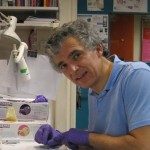Link to Pubmed [PMID] – 11782172
J. Am. Chem. Soc. 2002 Jan;124(2):205-15
Isothermal titration calorimetry and X-ray crystallography have been used to determine the structural and thermodynamic consequences associated with constraining the pTyr residue of the pYEEI ligand for the Src Homology 2 domain of the Src kinase (Src SH2 domain). The conformationally constrained peptide mimics that were used are cyclopropane-derived isosteres whereby a cyclopropane ring substitutes to the N-Calpha-Cbeta atoms of the phosphotyrosine. Comparison of the thermodynamic data for the binding of the conformationally constrained peptide mimics relative to their equivalent flexible analogues as well as a native tetrapeptide revealed an entropic advantage of 5-9 cal mol(-1) K(-1) for the binding of the conformationally constrained ligands. However, an unexpected drop in enthalpy for the binding of the conformationally constrained ligands relative to their flexible analogues was also observed. To evaluate whether these differences reflected conformational variations in peptide binding modes, we have determined the crystal structure of a complex of the Src SH2 domain bound to one of the conformationally constrained peptide mimics. Comparison of this new structure with that of the Src SH2 domain bound to a natural 11-mer peptide (Waksman et al. Cell 1993, 72, 779-790) revealed only very small differences. Hence, cyclopropane-derived peptides are excellent mimics of the bound state of their flexible analogues. However, a rigorous analysis of the structures and of the surface areas at the binding interface, and subsequent computational derivation of the energetic binding parameters, failed to predict the observed differences between the binding thermodynamics of the rigidified and flexible ligands, suggesting that the drop in enthalpy observed with the conformationally constrained peptide mimic arises from sources other than changes in buried surface areas, though the exact origin of the differences remains unclear.
